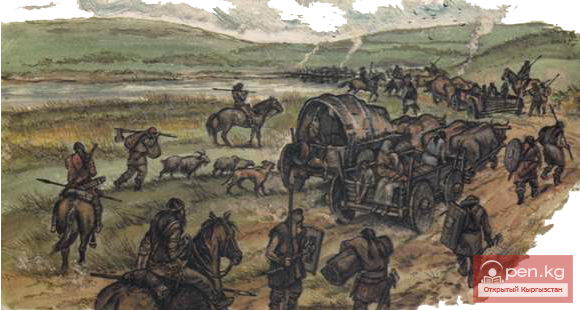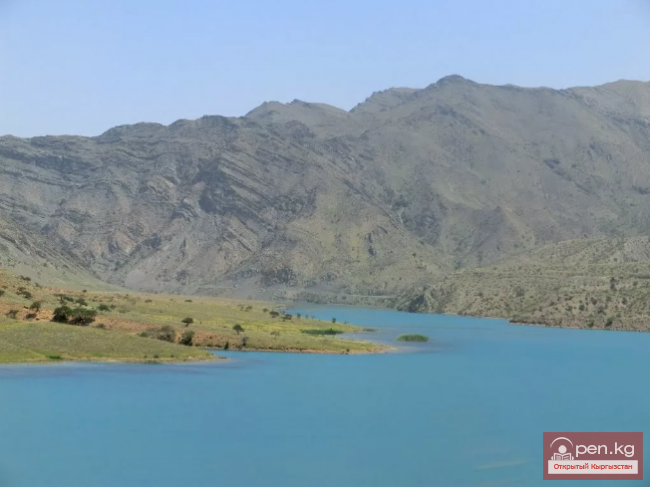Kyrgyzstan - Chronology of Major Historical Events
400,000 years ago - The oldest Stone Age monuments found in the Tien Shan.
3rd millennium, late 2nd millennium BC - The spread of copper, then bronze in the territory of modern Kyrgyzstan.
7th-5th centuries BC - Widespread distribution of iron in Central Asia.
7th-8th centuries BC - The Saka tribal union in the Tien Shan.
329 BC - The invasion of Central Asia by Alexander the Great.
2nd century BC - 6th century AD - The Usun tribal union in the Tien Shan.
5th century AD - The beginning of Sogdian colonization of Semirechye.
6th-7th centuries - The Western Turkic Khaganate.
8th-9th centuries - The Karluk Khaganate.
10th-12th centuries - The Karakhanid state in the Tien Shan. Construction of the Burana tower, the Shah-Fazil mausoleum, and the Uzgen architectural complex.
1072-73 - The compilation of "Di-vani lugat at-turk" ("Dictionary of Turkic Dialects") by Mahmud of Kashgar.
1211 - The establishment of the power of the Mongol-Naiman Khan Kuchluk in the Tien Shan.
1218-19 - The invasion of Genghis Khan's hordes and the establishment of Mongol power in the Tien Shan.
13th century, 2nd half - 14th century, mid - The East-Central Asian state with an administrative-political center in the Chu-Ili interfluve.
14th century, mid - The formation of the Mogolistan state.
1370-1430 - The struggle of the peoples of Mogolistan against the invasions of Timur's troops and the Timurids.
1484-1504 - The reign of Ahmed Khan in the Kyrgyz ulus - khanate.
15th century, late - 16th century, early - The formation of the Kyrgyz nationality.
15th century, second half - 16th century - The struggle of the Kyrgyz against the Mongols.
1510-24 - The reign of Emir Muhammad Kyrgyz in the Tien Shan.
16th century, first half - The first prose recording of the plots of the epic "Manas" by Seyf-ad-din Akhsikenti in "Majmu at-tavarikh" ("Collection of Histories").
1635-1755 - The struggle of the Kyrgyz against the Kalmyk (Oirat or Dzungar) feudal lords.
16th century, late - 17th century, early - The resettlement of part of the Kyrgyz from the Tien Shan to Pamir-Alai.
1755-58 - The defeat of the Oirat state by the Qing Empire in Eastern Turkestan.
18th century, 2nd half - The return of part of the Kyrgyz from Pamir-Alai and Eastern Turkestan to the Tien Shan, their resettlement in Northern Kyrgyzstan.
1762 - The publication of "Topography of Orenburg..." by P. K. Rychkov, which first published reliable information about the Kyrgyz of the Tien Shan in Russia. The capture of the city of Osh by the Kokand Khanate.
1770 - The invasion of the Kazakh Khan Ablai into the northern regions of Kyrgyzstan.
1785-89 - The first embassy to St. Petersburg from the Kyrgyz, who were nomadic in the eastern part of the Chui Valley and the upper reaches of the Chu River, requesting protection from Russia.
1813 - The embassy of the Kyrgyz from Eastern Prijssykul to the Russian authorities in Tobolsk.
1817-81 - The military campaigns of the Kokand Khans against the Kyrgyz.
1821 - The joint uprising of the Talas Kyrgyz and Syr Darya Kazakhs against the Kokand Khanate.
1824 - The embassy of the Kyrgyz from the Issyk-Kul basin to the Russian authorities of Western Siberia expressing a desire to accept Russian citizenship.
1825 - The foundation of the Kokand fortress Pishpek in the Chui Valley.
19th century, 30s - The uprising of the Naryn Kyrgyz against Kokand oppression.
1842-43 - The uprising of several northern Kyrgyz tribes against the khan's power, expelling the Kokand from their fortifications in Prijssykul.
1845 - The uprising of the Osh Kyrgyz against the oppression of the Kokand Khanate.
1847 - The appeal of the Kyrgyz of the Chui Valley of Central Tien Shan and the Issyk-Kul basin to the Russian authorities requesting to accept them as subjects of Russia.
1855, January 17 - The acceptance of the Kyrgyz of the eastern part of the Issyk-Kul basin into Russian citizenship.
1856-57 - The journey of P. P. Semenov (with the assistance of the Russian Geographical Society) to Lake Issyk-Kul and Northern Tien Shan.
1857 - The joint uprising of the Kyrgyz and Kazakhs against the oppression of the Kokand feudal lords, taking the city of Auliye-Ata (now the city of Jambyl).
1858 - The uprising of the southern Kyrgyz against the oppression of the Kokand Khanate. They took the city of Margilan. A joint uprising against the oppression of the Kokand Khanate by the Kazakhs and Kyrgyz in the territory from Tashkent to the Chu River.
1860, August-September - The capture of the Kokand fortresses Tokmak and Pishpek by Russian troops with the assistance of the Chui Kyrgyz.
1862, October 24 - The second capture of the fortress Pishpek by Russian troops together with Kyrgyz detachments.
1863, October 18 - The oath of the Kyrgyz of Ak-Sai and Chatyr-Kel to Russian citizenship.
1864, May - The establishment of the Russian fortification Tokmak.
1864, June-December - The acceptance of Russian citizenship by the Kyrgyz of Chatkal and Naryn. The final establishment of the authority of Tsarist Russia in Northern Kyrgyzstan.
1865, February 12 - The formation of the Turkestan region, which included the northern part of Kyrgyzstan (in 1867 transformed into the Turkestan General-Governorship).
1867 - The uprising of the Alai Kyrgyz against the oppression of the Kokand Khanate.
19th century, 60-80s - The beginning of the resettlement of Russian peasants to Kyrgyzstan and the establishment of several settlements in the Chui and Talas valleys and in Prijssykul.
1869 - The founding of the city of Karakol (renamed Przhevalsk on March 11, 1889).
1869-70 - The stay of V. V. Vereshchagin in Kyrgyzstan, who captured the nature of Kyrgyzstan, the life and customs of its population in his works.
1871 - The expedition of A. P. Fedchenko to southern Kyrgyzstan.
1873, January - The appeal of the southern Kyrgyz requesting to be accepted into Russian citizenship.
1876, February 19 - The abolition of the Kokand Khanate and the formation of the Fergana region. The incorporation of Southern Kyrgyzstan into Russia.
1877, December - 1883 - The resettlement of Dungans and Uyghurs to Kyrgyzstan.
1878, April 26 - early May - The settlement of Pishpek becomes a city - the center of the Tokmak (later Pishpek) district.
1898, May 17 - June - The Andijan uprising.
1905, spring - The uprising of Kyrgyz farmers against the bai, manaps, and tsarist authority in several volosts in Northern Kyrgyzstan. The miners' strike in Kyzyl-Kiya.
1908-11 - The construction of narrow-gauge railway branches from the station Skobelevo (Fergana) to Kyzyl-Kiya and from the station Dragomirovo to Sulyukty.
1912, December 12 - The opening of the Pishpek male gymnasium - the first secondary educational institution in Kyrgyzstan.
1915, May - The commissioning of the railway branch Gurunchmazar - Jalal-Abad.
1916, June 25 - The decree of the tsarist government on the mobilization of the indigenous population of Central Asia for rear work.
1916, July - October - The national liberation uprising and its suppression by tsarist troops.
1917, February 27 - The February bourgeois-democratic revolution. The overthrow of tsarism.
1917, April 17 - The formation of a united group of the RSDLP in Pishpek.
1917, October 25 (November 7) - The victory of the Great October Socialist Revolution in Petrograd.
1917, November - The establishment of Soviet power in Sulyukty and Kyzyl-Kiya.
1918, January - The establishment of Soviet power in Pishpek.
1918, March 5 - The organization of the Red Guard battalion in Pishpek, which later grew into the 1st Pishpek Soviet regiment.
1918, April 20, May 1 - The proclamation of the Turkestan ASSR at the 5th regional congress of Soviets.
1918, June 17-25 - The 1st Congress of the Communist Party (Bolsheviks) of Turkestan.
1918, December 7-28 - The kulak-white guard uprising in the village of Belovodsk and its defeat.
1924, October 14 - The formation of the Kara-Kyrgyz Autonomous Region.
1925, May 25 - The renaming of the Kara-Kyrgyz Autonomous Region to the Kyrgyz Autonomous Region.
1926, February 1 - The formation of the Kyrgyz ASSR.
1930 - The adoption of the first Constitution of the Kyrgyz ASSR at the 2nd Congress of Soviets.
1936, December 5 - The formation of the Kyrgyz Soviet Socialist Republic.
1937, March 23 - The adoption of the Constitution of the Kyrgyz SSR.
1940 - The transition to the Russian alphabet.
1940, May 10 - The beginning of the construction of the Big Chui Canal.
1950 - The commissioning of the railway line Bystrovka-Rybachye.
1979 - The commissioning of the Toktogul HPP at full capacity.
1989, September 23 - The adoption of the Law of the Kyrgyz SSR "On the State Language".
1990, June 4 - The Osh events.
1990, October 27 - The election of A. Akayev as President of Kyrgyzstan in the Jogorku Kenesh.
1990, December 15 - The adoption of the Declaration of Sovereignty of Kyrgyzstan by the Jogorku Kenesh.
1991, August 31 - The adoption of the Declaration "On the State Independence of Kyrgyzstan" in the Jogorku Kenesh.
1991, October 12 - The election of A. Akayev as the first President of Kyrgyzstan in nationwide elections.
1991, December 21 - The entry of Kyrgyzstan into the Commonwealth of Independent States.
1992, March 2 - The entry of Kyrgyzstan into the United Nations (UN).
1993, May 5 - The adoption of a new Constitution of the Kyrgyz Republic.
1993, May 10 - The introduction of the national currency - the som.
1995, August 26-30 - The celebration of the 1000th anniversary of the epic "Manas".
1995, December 24 - The election of A. Akayev as President of the Kyrgyz Republic in nationwide elections.
1998, January 22 - The flight into space of Kyrgyz native Salizhan Sharipov as part of the crew of the American 89th expedition (Space Shuttle).
December 20, 1998 - Kyrgyzstan joined the World Trade Organization.
1999 - The population census of Kyrgyzstan.
1999-2001 - Military actions in the Batken region. The invasion of armed formations of the Islamic Movement of Uzbekistan.
May 25, 2000 - The Russian language was granted official status.
October 29, 2000 - The election of A. Akayev as President of Kyrgyzstan for a third term.
2001 - The placement of the American airbase Manas.
August 27, 2002 - The birth of the five-millionth resident of Kyrgyzstan.
2002 - The Aksy events.
October 23, 2003 - The opening of the "Kant" airbase.
March 24, 2005 - The Tulip Revolution, which ended the 15-year rule of Askar Akayev (1990-2005).
2005 - Kurmanbek Bakiev becomes President.
February 10, 2006 - New amendments to the Constitution were introduced. The powers of the president were strengthened, and the parliament could hardly influence the decisions of the head of state.
January 1, 2008 - The first coins since gaining independence were put into circulation. The set includes coins of 5 soms, 3 soms, 1 som, as well as 50 tyiyn, 10 tyiyn, and 1 tyiyn.
April 7, 2010 - The overthrow of Bakiev. Power passes to the interim government headed by Roza Otunbayeva, and a new constitution was adopted, establishing a parliamentary form of government in the country.
October 30, 2011 - A. Atambayev was elected President.
September 9, 2014 - The 1st World Nomad Games took place - international sports competitions in ethnic sports.
August 6, 2015 - The Treaty on the Accession of the Kyrgyz Republic to the Eurasian Economic Union came into force. The Republic became the fifth member of the EAEU along with Armenia, Belarus, Kazakhstan, and Russia.
October 28, 2015 - In New York, at the 42nd plenary session of the UN General Assembly, Kyrgyzstan was elected a member of the UN Human Rights Council, receiving 174 votes from 192 states that are members of the UN.
November 25, 2015 - The six-millionth Kyrgyzstani was born in the republic.
October 15, 2017 - Following the presidential elections in Kyrgyzstan, Sooronbay Jeenbekov became president.
History of Kyrgyzstan. Video 20 episodes
















































